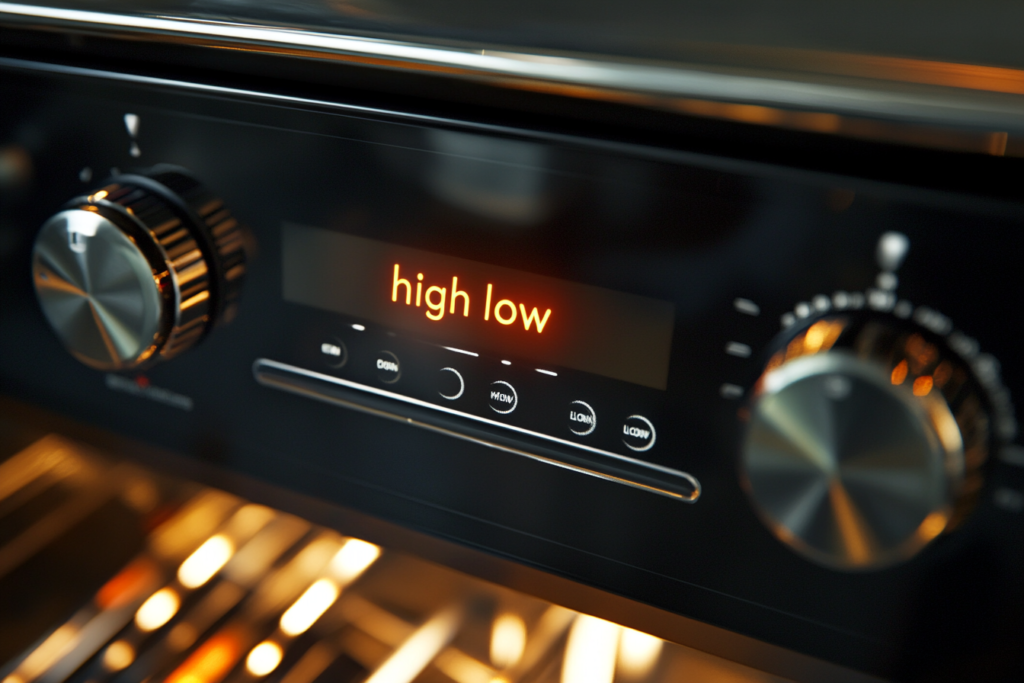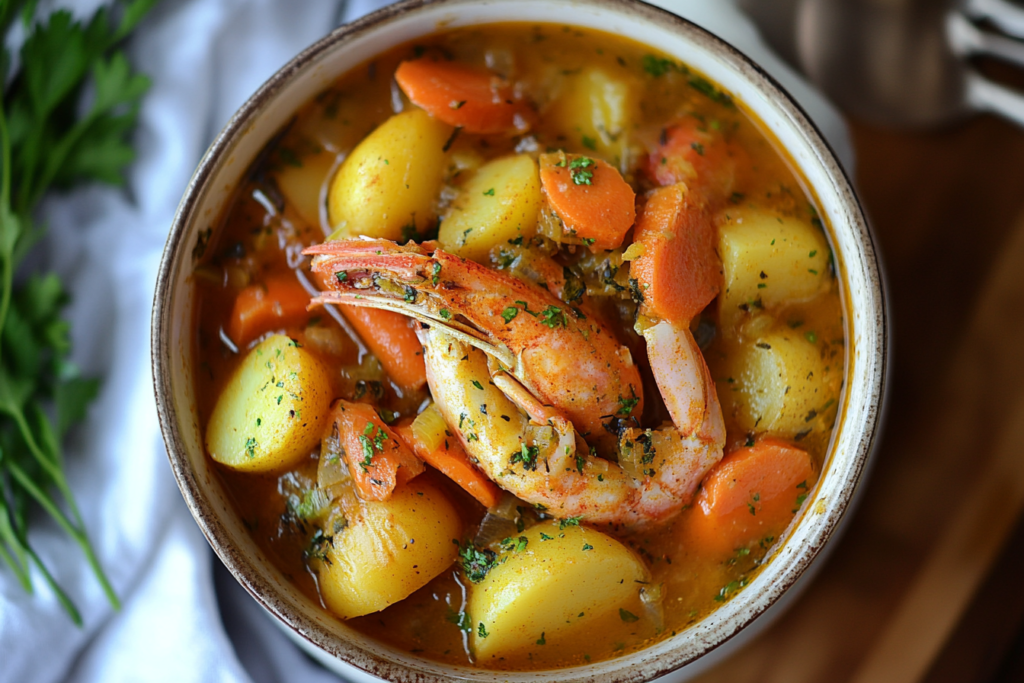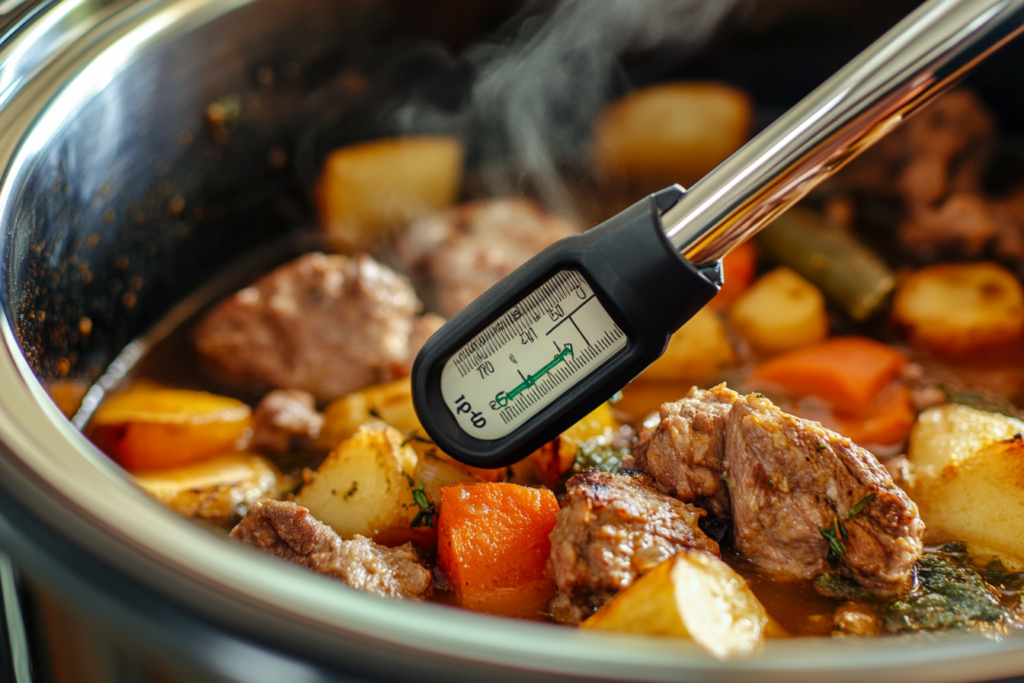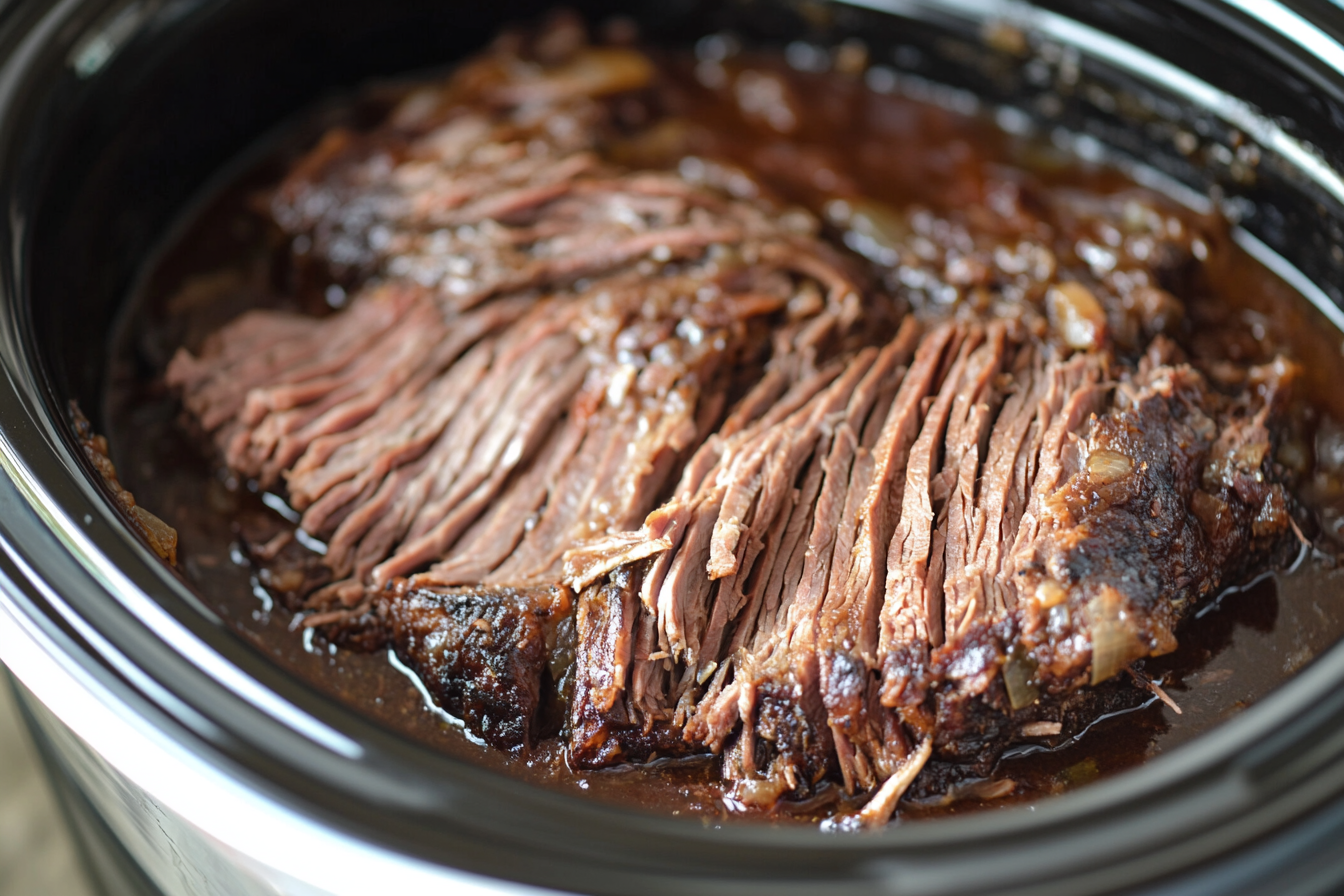Table of Contents
Slow Cooker Cooking: Understanding High vs. Low Settings
Many recipes call for cooking food in a slow cooker on high or low, but is 4 hours on high the same as 8 hours on low? This is a common question among home cooks. Understanding these differences is key to successful slow cooking. So, let’s explore this further.
The simple answer is: often, but not always. The difference isn’t just about cooking time—it also affects the texture, flavor, and overall outcome of the dish.
How Slow Cooker High and Low Settings Differ

Slow cookers have two main settings: high and low. The high setting heats up faster. Conversely, the low setting takes longer to reach cooking temperature. Generally, the “low” setting will reach about 200 degrees Fahrenheit. The high setting can get up to 300 degrees Fahrenheit. However, there are some variations. Some cookers run hotter or cooler. Therefore, understanding your specific slow cooker is important. The low setting provides a more gentle heat. Consequently, the low setting is better for tougher cuts of meat. This helps break down the fibers and tenderizes the food.
The Impact of Total Cooking Time in a Slow Cooker
The total cooking time affects the final food quality. If 4 hours on high the same as 8 hours on low? No, not exactly. Even though the total cooking time might seem similar, the methods are not equivalent. Faster, hotter cooking on high can sometimes lead to drier outcomes. This is because the food loses moisture more quickly. Therefore, it’s not always ideal, especially for delicate items. On the other hand, a longer, gentler cooking on low lets the food’s flavors meld fully and creates juicy results. So, while the total cooking time might appear similar, the difference impacts the texture and overall quality.
Is 4 Hours on High Equivalent to 8 Hours on Low?: A Detailed Look
The common idea is that one hour on high equals about two hours on low. However, this is not a strict rule. Consequently, the cooking time may vary. Several things may affect this time. These include your slow cooker, the specific recipe, and food quantities. Furthermore, food that needs more tenderization will generally benefit from the longer, slower cooking on low. So, while the heat intensity differs, the goal is still to cook the food thoroughly. For example, using high for 4 hours can sometimes have similar results. However, the texture and tenderness can vary quite a bit.
Matching Food Types to the Right Slow Cooker Setting
Certain foods cook better with particular settings. Tougher cuts of meat, like beef brisket or pork shoulder, benefit greatly from low and slow cooking. This longer cooking time allows the fats and collagens to break down. This results in a more tender and moist meal. However, delicate items, such as seafood or certain vegetables, can overcook easily on the high setting. Therefore, the low setting works better for these foods. Consequently, for recipes with smaller pieces of meat or items that do not need much break down, the high setting can be convenient, and still provide great results.
Flavor Development: High vs. Low Slow Cooking
A major difference between using high versus low is flavor development. Longer cook times at lower heat, namely cooking on low, allow flavors to blend and deepen. Therefore, the result is a more complex taste. The gradual cooking process helps all the ingredients to come together nicely. Is 4 hours on high the same as 8 hours on low for flavor? Definitely not. However, cooking on high for 4 hours can be more convenient if you are short on time. Ultimately, it can still produce tasty food. The key is to understand how to adjust recipes and settings.
The Crucial Role of Liquid When Using High or Low
Liquid plays an important role. It creates steam, which helps to cook food, and it prevents burning. Because cooking on high uses more heat, more liquid evaporates. Therefore, recipes on high often need more liquid to keep the food from drying out. However, using low heat will not dry the food as fast. Consequently, knowing how much liquid to use can make a big difference. Additionally, it is useful to keep an eye on the liquid level. Adding more as needed is sometimes necessary.
How to Adapt Recipes for High or Low Slow Cooker Settings
Many recipes will specify whether to use high or low. However, you can adjust most recipes. This is possible if you understand the differences between the two settings. For instance, if a recipe calls for 8 hours on low, and you are short on time, you can reduce the time. You can often use the high setting for about 4 hours. Conversely, if a recipe says to use high, and you prefer low, you’ll need to increase the cooking time. However, it’s essential to monitor the food. This will prevent overcooking or undercooking. Therefore, adjustments during the cooking process can help.
When is the High Slow Cooker Setting Best?
The high setting works well when you are short on time, and you need a quicker cooking process. Furthermore, it’s good for small pieces of meat or items that do not need long to break down. For example, soups and chilis with pre-cooked meats or ground meat are good options for this setting. Remember to monitor the liquid level more when you cook on high. This prevents the food from drying out. Additionally, if you want a faster choice, the high setting works well. However, always check your food. Ensure that the ingredients do not become too dry.
When is the Low Slow Cooker Setting the Right Choice?

The low setting is beneficial for tougher cuts of meat. These types of meats need a longer cooking time to become tender. Therefore, it is also useful for meals that benefit from more flavor development. With low heat, all the ingredients can blend. This setting works great for stews, roasts, and other meals that are better when cooked longer. Using the low setting is also good for a more hands-off cooking approach. There is a lower risk of burning or overcooking. Therefore, when you have more time, using the low setting is usually best.
Key Slow Cooker Safety Tips for High and Low Cooking

Always be safe with food. Ensure the food reaches a safe temperature. This is important with slow cooking. A food thermometer will help you be sure the food is fully cooked. Make sure your slow cooker works well before you start to cook. Also, do not open the lid while cooking, unless needed. Doing so will release heat and could increase the cooking time. Moreover, when you use a slow cooker, place it on a safe surface that can handle heat. Using your slow cooker safely provides the best results.
Monitoring Food During High or Low Slow Cooking
Whether you cook on high or low, watching your food is very important. Keep an eye on the amount of liquid. Make sure nothing is sticking to the bottom of the cooker. It is better to check your food sooner than later. This will let you make any necessary adjustments. Always remember that a food thermometer is helpful. This will make sure that your food is fully cooked. Consequently, monitoring makes sure you will get the best results for each recipe.
Making the Right Choice: Selecting Between High and Low
Deciding if 4 hours on high is the same as 8 hours on low depends on several things. These things include the recipe, the food type, and how much time you have. Is 4 hours on high the same as 8 hours on low? While many think that one hour on high equals two hours on low, this is not always exact. Moreover, since your main goal is to cook food properly, you can change your settings. Always monitor your food. Consider what is best for each dish you are preparing.
Understanding Your Specific Slow Cooker and Its Performance
Every slow cooker cooks in a slightly different way. Some models may run hotter, and others may be cooler. Therefore, knowing your specific appliance is important. Look at your cooker’s manual to understand its heat range. Furthermore, watch your cooker. See how it cooks using the high and low settings. Consequently, this helps you adjust cooking times when you need to. It can help to understand how 4 hours on high compares to 8 hours on low with your specific appliance.
How to Achieve Optimal Results with Either High or Low
To get great results, try cooking on both high and low. Keep notes about your cooking. Include the time, temperature, and amount of moisture. This helps you to see how each setting affects your recipes. For example, making the same meal using both high and low can show you the differences. Therefore, this is a great way to find the method that gives you the results you prefer. Additionally, use your notes to help with future recipes and changes.
The Science Behind Different Slow Cooker Cooking Times
Understanding the science of slow cooking shows why the settings matter. The low setting keeps a gentle heat. This slow process breaks down tough fibers and tissues in meats. Conversely, the high setting has a faster, higher heat. Is 4 hours on high the same as 8 hours on low when looking at the science? Not quite. The low method spreads heat more evenly. Therefore, it prevents scorching. It also lets flavors blend over time. Consequently, the high setting can be useful when you have less time. However, you need to watch out for dryness.
Adapting Recipes for Various Slow Cooker Models
Different slow cookers can perform differently. Therefore, a recipe that works well in one slow cooker might not work in another. Some slow cookers heat up quickly, and might run hotter. Other models might be slower and gentler. When you start new recipes, use a shorter cooking time at first. Check on the food often. Then, add more time as needed. This helps to prevent overcooking. It also helps you to understand your appliance. Ultimately, adjusting recipes is important for good results.
The Influence of Food Quantity on Slow Cooker Cooking Time
The amount of food that you place in the slow cooker can affect cooking time. A slow cooker that is half full will cook faster than one that is full. When you change recipes, keep this in mind. If you use more ingredients, you will likely need more cooking time. On the other hand, cooking small amounts of food may take less time. Therefore, change cooking times based on the amount of food. Monitoring the food and a food thermometer will help make sure everything is cooked properly.
Troubleshooting Common Slow Cooking Problems
Sometimes, slow cooking does not go as planned. Common issues include dry food, tough meats, or uneven cooking. Dry food can often be fixed by adding more liquid during cooking. Tough meats often mean that more cooking time is needed, preferably on low. Uneven cooking might come from uneven ingredients. Therefore, stirring the food partway through will help. Also, ensure that the slow cooker is not too full. Ultimately, knowing how to fix these issues will improve slow cooking.
The Benefits of Pre-Cooking in Slow Cooking
Some cooks like to sear meat before putting it in the slow cooker. Searing adds a depth of flavor. Pre-cooking onions and garlic can also make a dish taste better. Although pre-cooking isn’t always needed, it can make a recipe better. Therefore, think about doing this for added flavor. You can also use your slow cooker to make pre-made meals even better.
Meal Prep Strategies Using High and Low Slow Cooking
Slow cookers are great for meal prep. Cooking big batches of foods like soups, stews, or shredded meat works well for busy weeknights. You can freeze and store the prepared food easily. Then, you can use them for other meals. Therefore, slow cooking can save time and effort. Consequently, this makes it a great tool for busy people. In addition, slow cooking lets you have a hot meal any time during the week.
Advanced Slow Cooking Techniques for Enhanced Flavor
Advanced slow cooking can improve your cooking. Using different seasoning methods can really help. For example, dry rubs or marinades can make your food taste much better. Experiment with herbs, spices, and different flavor combinations. These techniques will make your slow-cooked meals much better. In addition, using quality ingredients makes a big difference. Consequently, taking some time to learn will improve your slow cooking.
The Art of Adjusting Slow Cooker Recipes to Your Liking
The art of slow cooking often includes changing recipes to fit your own tastes. Many slow cooker recipes can be modified. You can add your preferred flavor combinations. Do not be afraid to add spices, herbs, or vegetables that you like. Furthermore, you can try different amounts of liquids or cooking times. So, as you try different things and adjust the recipes, you will learn more about the best way to cook the meals you like.
Slow Cooking Options for Special Dietary Needs
Slow cookers are useful for people with specific dietary needs. For example, gluten-free and dairy-free recipes are easy in a slow cooker. You can also prepare protein-rich meals. You can control the ingredients and serving sizes. This makes slow cooking a good option for many people. Moreover, slow cooking can be adjusted easily, and it works for different dietary needs.
Essential Tips for Cleaning Your Slow Cooker Effectively
Keeping your slow cooker clean is very important. After each use, allow your slow cooker to cool. Wash it with hot, soapy water. If food is stuck to the bottom, soak it in warm water first. This will make it easier to clean. Never use harsh cleaners or scouring pads. These can damage the surface. Use a non-abrasive sponge. Moreover, correct cleaning will help your slow cooker last longer.
Conclusion
In conclusion, while people say that 4 hours on high is the same as 8 hours on low, it is more complicated. The settings offer different benefits. The slow, gentle cooking on low results in more tender and flavorful food. Is 4 hours on high the same as 8 hours on low? Not really, but both settings work. It is also important to understand that the final result depends on multiple things. These things include the type of food, the amount of liquid, and how well you watch the food. Change your cooking times and settings to get the best results in your own slow cooker.
Frequently Asked Questions (FAQs)
Does 8 hours low equal 4 hours high in a crockpot?
Generally, yes, but with variations. Eight hours on low is often considered comparable to 4 hours on high. However, the results are not always identical. Low is gentler, leading to more tender food. High heat cooks faster.
Is 6 hours on low the same as 4 hours on high?
No, 6 hours on low is not typically the same as 4 hours on high. Six hours on low will usually result in a longer cooking time than 4 hours on high. The low setting develops deeper flavors. Therefore, cooking on low takes longer. However, 4 hours on high can sometimes be an adequate substitute, if time is limited.
Does it matter if you cook on high or low in a slow cooker?
Yes, it matters. High heat is faster, but can dry food. Low heat develops flavors and tenderizes more. Therefore, the choice depends on the type of food and the time available. Both settings cook the food through, but the quality is not always equal.
Is 4 hours enough for a slow cooker?
Yes, 4 hours can be enough for a slow cooker on the high setting. However, this depends on the recipe. Smaller pieces of meat, soups, and certain vegetables can be done in four hours on high. However, tougher cuts of meat generally need longer on low.

